
THE PUMMELO IN HAWAII
SCIENTIFIC NAME: Citrus species
FAMILY: Rutaceae
WHAT IS A PUMMELO?
Pummelos and grapefruits are closely related, and indeed the grapefruit was derived from the pummelo, probably by natural hybridization. But their differences are numerous. The pummelo looks like a grapefruit but it is larger, up to five pounds in weight, and more varied in shape, sometimes oval or pear-shaped rather than round. It is sweeter, although pummelo can also be highly acid and bitter. The rinds are very often thicker, and the flesh is more firm; segments can be separated and membranes removed, making it easy to eat with the fingers. The pummelo is one more idea for Hawaii citrus growers.
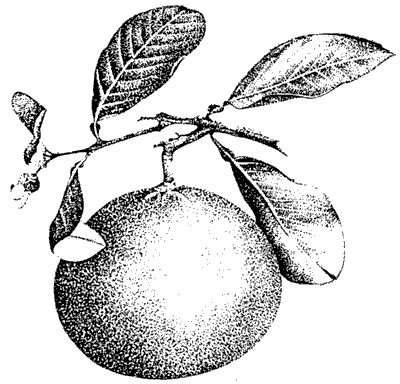
The pummelo (Citrus maxima) is indigenous to the Malayan peninsula and East Indian archipelago, and has spread from there to South China, India, and finally to other parts of the world. Other names by which it is known are shaddock in Barbados (named after a Captain Shaddock), pompelmoes in Indonesia, pamplemousse in French Oceania, butan or zabon in Japan, Som-O in Thailand, and pummelo or poolook in Hawaii. In the Hawaiian Islands, pummelos are grown from sea level up to 1,500 feet elevation, and usually the trees are located in home gardens below 200 feet elevation. The temperature range in areas where they are grown varies from a low of 60-65°F in winter to a high of 85-90° in late summer and early fall. (Illustration by Glen Tankard in Exotic Tree Fruits.)
USES
Pummelos are principally eaten as fresh fruit or used as an ingredient in fruit salads. Sometimes the rind is sliced and made into candied peel or cooked and eaten as a vegetable. The fruit is popular with the Chinese and is prominently displayed by them in religious ceremonies, during New Year's festivities, and as a decorative piece in the home; it is ideal for these purposes because of its long shelf life and attractiveness. Pummelo trees are often used to accent the entrances to Chinese gardens and homes.
When pummelos are eaten as fresh fruit, the covering or capillary membrane around each segment is peeled off, and in good quality pummelos this membrane is easily removed. At the same time, the walls of exposed juice sacs should be strong enough to keep the juice from leaking out.
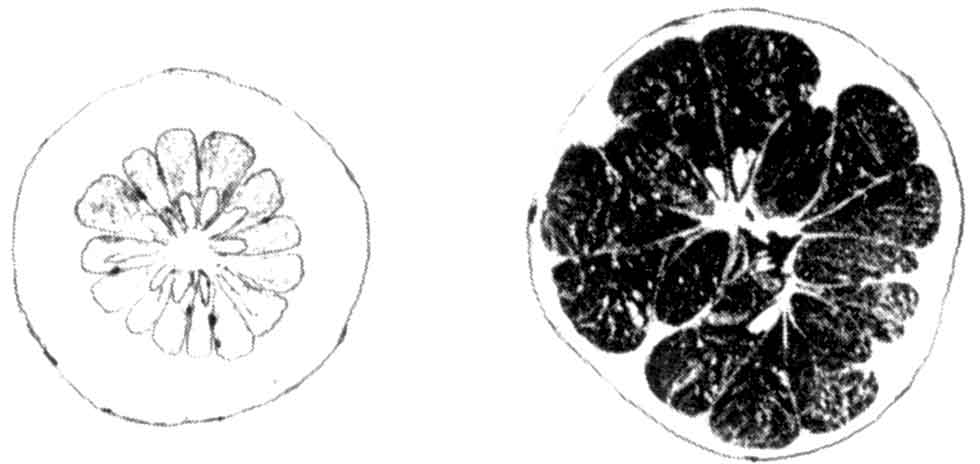
VARIETIES
Hawaii has a great many seedling pummelos in home gardens, but most of them are of poor eating quality. (Figure above) They may be bitter, seedy, thick-skinned, poorly segmented, or very acid. Poor quality seedling pummelos are generally unpalatable as fresh fruit. Among the many seedlings and imported varieties grown in Hawaii, however, some are of good to excellent quality, including 'Au', 'Chandler', 'Diamond Head', 'Ho'; 'Kao Pan', 'Kau', 'Pauthel', 'Sakata', and others.
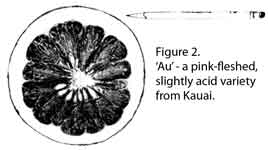
AU (Figure 2 above)
Seedling planted at Papaa Homestead, Kauai, more than 40 years ago by the late Tai Hon Au. Shape oval to collared (in some varieties other shapes can appear on the same tree, but normally one form predominates). Rind dark yellow, ½ -inch thick, and surface slightly rough. Flesh dark pink around segment membrane, and lemon-coloured toward the center. Segments well formed, small to medium, membrane fairly easy to remove. Juice sacs fine and compact. Flavour slightly acid to acid with slight bitterness. Best eaten when full ripe. Weight: 1½-2½ pounds. Season: October to January.
CHANDLER
Pink variety resulting from a 'Siamese Pink' pollen parent and a 'Siamese Sweet' seed parent, bred and released by Dr. James Cameron, University of California at Riverside. Shape oblate to globose. Rind yellow, about ¾-inch thick, and smooth. Flesh moderately juicy and pink. Juice sacs loosely held together. Segments well formed and large. Flavour slightly acid but sweet. Weight: 3-3½ pounds. Season: October to November.
DIAMOND HEAD
Large, attractive, light-pink variety. Shape subglobose to spherical. Rind attractive yellow and about ¾-inch thick. Flesh moist and slightly pink near rind. Segments medium and uniform with juice sacs easily broken. Flavour slightly acid to sweet. Weight: about 3 pounds. Season: October to November.
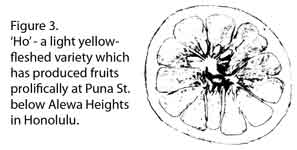
HO (Figure 3)
Seedling from Waialua, Oahu. Shape broadly pyriform. Rind yellow, 3/8 inch thick. Flesh moist and pale yellow. Juice sacs compact but easily broken. Segments small to medium and well formed with membrane slightly difficult to remove. Flavour slightly acid but sweet with a trace of bitterness. Weight: 1½-2 pounds. Season: September to November.
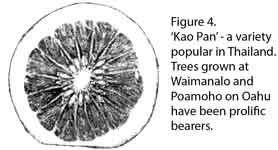
KAO PAN (Figure 4)
Introduced from Thailand by the U.S.A. and obtained from the University of California Citrus Research Center by the Hawaii Agricultural Experiment Station. Shape subglobose to spherical. Rind bright yellow, ½ inch thick, and smooth. Flesh lime-coloured and juicy. Juice sacs large and easily separated from segment membrane. Segments well formed. Flavour sweet and slightly acid. Weight: about 3 pounds. Season: October to November.
KAO PHUANG
Imported from Thailand by the University at Riverside. Shape broadly pyriform with short neck. Rind yellow and about 3/8 thick. Flesh juicy and greenish in color. Segments large and uniform with juice sacs held firmly to base of segment membrane. Flavour moderately acid but pleasant. Weight 2-3½ pounds. Season: October to December.
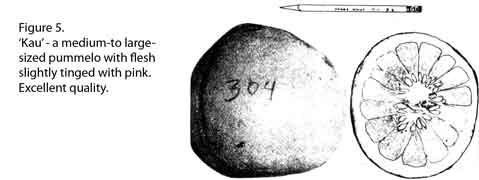
KAU (Figure 5)
Seedling from seed brought from China and planted by Nancy Kau, 650 Ninth Avenue, Kaimuki, Oahu. Shape broadly obovoid. Rind yellow, about ½ inch thick, and easy to peel. Flesh moderately moist and tinged with pink next to rind. Segments large and well formed with membrane easily separated. Juice sacs firm and fairly compact. Flavour slightly acid, but sweet. Bitterness slight and infrequent. Weight: 3-4 pounds. Season: September to October.
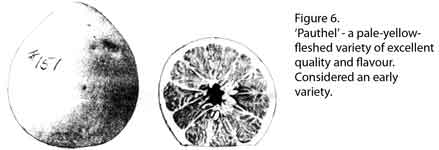
PAUTHEL (Figure 6)
Seedling grown by Paul Wong, Aliikoa Street, Kaimuki, Oahu. Shape pyriform to obovate. Rind light yellow and about 3/8 inch thick. Flesh moderately juicy and pale yellow. Juice sacs firm and compact. Segments well formed and large with membrane easily removed. Flavour sweet and slightly acid. Weight 2-3 pounds. Season: August to September.
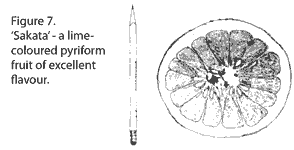
SAKATA (Figure 7)
Discovered and grown by Mrs. Hatsu Sakata, 45- 623 Keaahala Road, Kaneohe, Oahu. Shape pyriform to obovate. Rind light yellow ¾ inch thick, and smooth. Flesh lime-coloured and juicy. Juice sacs medium and easily broken. Segments medium in size and well formed. Flavour slightly acid but sweet. Weight: 1½-2½ pounds. Season: August to September.
SIAMESE
Deep pink variety. Shape oblate. Rind yellow and about ¼ inch thick. Flesh juicy. Segments large but lacking in uniformity. Juice sacs tender and easily separated from segment membrane. Flavour moderately acid. Weight: 2½-3½ pounds. Season: September to October.
CULTURE
CLIMATE
Pummelos grow well from sea level up to 2000 feet elevation, and in most of the areas where other citrus are cultivated in Hawaii, they also flourish. Rainfall is not as important for growth if supplementary irrigation is provided. As is true for many other trees, wind is detrimental to pummelos, often making it necessary to provide windbreaks, especially on the windward side of the Islands. Trees should be planted in full sunlight for optimum growth and yields. In Hawaii, temperature seems to be a critical factor affecting fruit quality and bearing season, and the best quality fruits so far have been produced in warm locations below 500 feet elevation.
SOIL
Pummelos will grow on a wide range of soils. Well-drained soils with good textures and depths are considered ideal, examples of which include the red or reddish-brown soils of Lahaina, Maui and Waipahu, Oahu. On sandy, infertile soil, such as that found on the coastal areas of Oahu, the introduction of compost, red topsoil, and an adequate fertilizer program will help to promote normal growth.
SEASON
The season of maturity for pummelos in Hawaii extends from August to January; however, September to November is the period of greatest production. Off-season fruits are sometimes available in limited quantities during other times of the year.
HARVESTING
Some varieties can be harvested from the tree with good quality fruits when the skin is still greenish yellow; however, most varieties must be fully yellow before harvesting. Fruits harvested prematurely are more acid and drier than they should be. Those harvested just before they fall naturally tend to be less acid, sweeter, and juicier.
PROPAGATION
The three most common methods of propagating pummelos are by seeds, air layering(marcottage), and grafting. At present, most pummelo trees are grown from seeds in home gardens; the trend, however, is toward air-layered and grafted trees.
Fruits from trees grown from seed are usually different from and of poorer quality than improved selections and varieties which are propagated asexually. Asexually propagated trees with known fruit quality, therefore, are usually recommended for home garden planting, but the grower or hobbyist who is interested in finding variations can experiment by planting seeds of one of the better pummelos. Trees grown from seed generally take five years or more to bear fruit.
Air layering is presently the most common method of propagation. Trees produced in this way frequently set fruit in 5-gallon containers in 2 to 3 years and are attractive displays in garden shops.
Pummelos may be grafted on a number of different rootstocks, but, since little research information is available, it is satisfactory in most cases to graft pummelos on pummelo rootstock. It usually takes approximately a year to grow a rootstock large enough for grafting. Among rootstocks upon which pummelos have been successfully grafted are rough lemon and 'heennaran'. Trees grafted on rough lemon more than 15 years ago have shown no signs of incompatibility and are still producing well at Kihei, Maui.
TRANSPLANTING
Seedlings, grafted trees, or air-layered trees should be transplanted into the garden, normally when they reach a height of 1½ feet or larger and have well-matured leaves. In transplanting, the hole should be approximately 2 feet wide and 1½ feet deep to give the newly transplanted tree ample room to begin growth. The hole should be dug in an area far enough from other trees to avoid roots competing for space. One pound of treble superphosphate or two pounds of superphosphate should be placed at the bottom of the hole and covered with one inch of soil. The plant is then placed in the hole, and the root system is covered with soil so that the soil level is approximately 1½ to 2 inches higher than it was in the container. This is to insure that the soil level at the base of the tree after the soil settles into the hole will be about the same as before. Then a handful of complete fertilizer, such as 10-10-10, or any other fertilizer with a similar ratio of nitrogen(N), phosphorus(P205) and potash (K2O) is applied by scattering it into the basin over the surface of the hole. Finally the tree is watered.
FERTILIZATION
After planting, about a handful of fertilizer should be applied every second month during the first year of growth. The amount is gradually increased each following year, and one suggestion for the schedule is as follows:
2nd year - every 3 months - ¼ to ½ pound.
3rd year - every 4 months - 1 to 2 pounds.
4th year - every 4 months - 2 pounds.
5th year and thereafter - a minimum of 1 to 1½ pounds per inch trunk diameter per year which may be divided into 2 or 3 applications per year.
The time and amount of fertilization for bearing pummelo trees have not been fully determined, but recommendations made for other citrus trees may be applicable.
IRRIGATION
Young transplanted trees require plenty of water and should be irrigated at least twice a week during the first year. A weekly irrigation should be sufficient thereafter for the drier sections of the State. As the trees increase in size, the area irrigated should also be enlarged to cover at least two feet beyond the drip line of the branches.
DATE: March 1987
* * * * * * * * * * * * * * *
